Home » Rocks » Sedimentary Rocks » Puddingstone
Puddingstone
A conglomerate composed of pebbles in a matrix of contrasting color.
Article by: Hobart M. King, PhD
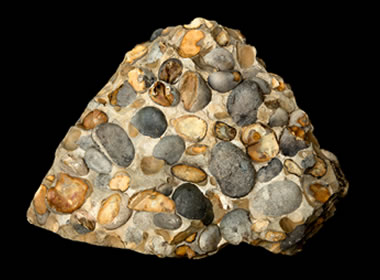
Puddingstone: A specimen of the Hertfordshire puddingstone, a conglomerate composed of rounded pebbles, mostly of flint, in a silicate matrix of contrasting color. Image by John Cancalosi / Alamy Stock Photo.
What is Puddingstone?
Puddingstone is a nonscientific name for a conglomerate in which subrounded to rounded pebbles occur in a matrix of sharply contrasting color.
The name "puddingstone" was first used in Great Britain where the rocks were said to "look like a plum pudding". A well-known example is the Hertfordshire Puddingstone, from the lower Eocene of the London Basin. It consists of colorful flint pebbles in a white to brown silicate matrix (see accompanying photo). It is a rock found at many locations in Hertfordshire County, England.
An Eye Magnet
Puddingstones immediately catch the eye of the geologist and the eyes of people who otherwise have no special interest in rocks. People have an immediate interest in the rocks and carry them home from beaches, streams, and wherever they are found.
Many particularly nice specimens find a place on desks, bookshelves, window sills and other locations where they will be seen by and delight even more people. Their popularity greatly exceeds their abundance.
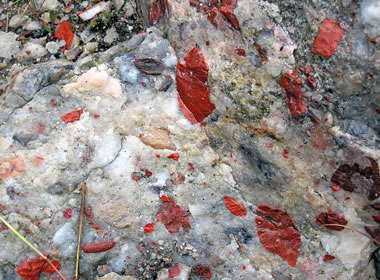
Two-Billion-Year-Old Puddingstone: This photograph shows a beautiful jasper-quartz conglomerate in the 2.3-billion-year-old Lorrain Formation of southern Ontario, Canada (near Ottertail Lake and the community of Bruce Mines). Glacial erratics of this and similar rocks are found scattered throughout the Great Lakes region of the United States. Rockhounds prospecting the shores of the Great Lakes hope to find nice rounded specimens with abundant clasts of red jasper. The best specimens will be displayed on bookshelves and in specimen cases of rock collectors. They are also used to make a variety of lapidary projects. The more red jasper, the better the specimen. Photograph and some caption content by James St. John. Image displayed here under a Creative Commons Attribution License.

Limestone Puddingstone: A specimen of limestone conglomerate from the Bull Run Formation (Triassic), which outcrops in Frederick and Montgomery Counties, Maryland, and Loudoun County, Virginia. It contains clasts of limestone, dolomitic limestone, quartzite, schist, greenstone and other rock types in a matrix of red clay and calcite cement. It is known as the Potomac Marble where it has been metamorphosed. This material was quarried and used to make the pillars in the statue room of the United States Capitol Building in Washington, DC. Many geologists who drive through the area where this rock is exposed will notice it and pull over to get a closer look. Its appearance is that striking - even from a distance of 50 yards. Photograph and caption content by John Cancalosi / Alamy Stock Photo.

Limestone Puddingstone: A spectacular example of a puddingstone from the Bull Run Formation of Frederick County, Maryland. This specimen features abundant gray clasts of limestone bound together by a reddish brown matrix. It is a Triassic-age rock containing clasts from lower Paleozoic rock units. This rock unit is known as the Leesburg Limestone where it is a sedimentary rock, and as the Potomac Marble where it has been metamorphosed. Photograph and some caption content by John Cancalosi / Alamy Stock Photo.
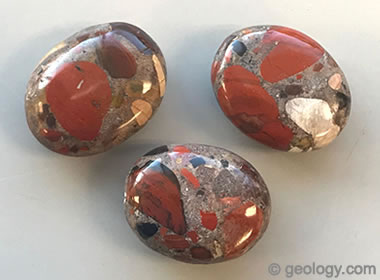
Red Jasper Puddingstone: Three palm stones cut from a jasper conglomerate found in India. Jasper conglomerate is a good formal name for this material. It fits the definition of conglomerate and red jasper is the dominant clast in these specimens.
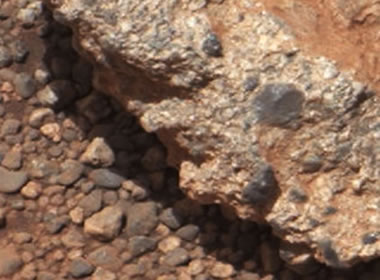
Puddingstone Discovered on Mars: In 2012, NASA's Curiosity rover discovered a weathered outcrop of puddingstone on Mars. Observed was a puddingstone with pebbles up to one centimeter in diameter and a surface scatter of rounded pebbles that were probably weathered from the outcrop. This is one of many locations where Curiosity discovered rocks on Mars that were very similar to the rocks found on Earth.
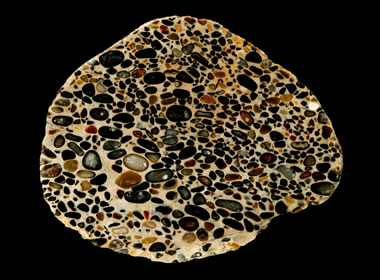
French Puddingstone: A puddingstone composed of brown and black pebbles in a white matrix. A slice from a sedimentary rock found in France. Photograph by John Cancalosi / Alamy Stock Photo.
| More Rocks |
 |
Tumbled Stones |
 |
Fossils |
 |
Geodes |
 |
The Rock Used to Make Beer |
 |
Topo Maps |
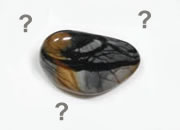 |
Difficult Rocks |
 |
Fluorescent Minerals |
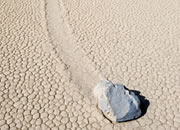 |
Sliding Rocks on Racetrack Playa |

Find Other Topics on Geology.com:

|

| ||

|

| ||

|

| ||

|

|
